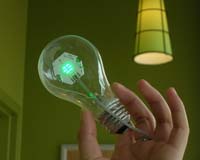 |
Newtown PA (SPX) Feb 16, 2011 Lockheed Martin has collaborated with The Pennsylvania State University to develop a breakthrough material that can significantly improve the performance of spacecraft antennas. The electromagnetic metamaterial is considered to be the first commercially viable product of its kind and is one of the first practical implementations of electromagnetic metamaterials that improves a real-world device. Lockheed Martin's University Research Initiative (URI) Program funded the initiative, which produced a metamaterial used in a horn-shaped satellite antenna. Leveraging a partnership spanning several years, the latest Lockheed Martin-Penn State collaboration combined concepts envisioned by Dr. Erik Lier of Lockheed Martin Space Systems Company with Penn State's expertise. The collaborative effort was featured in a recent issue of Nature Materials, one of the world's most prestigious and highly cited science journals focused on all topics within the combined disciplines of materials science and engineering. Metamaterials have properties not found in nature. Electromagnetic metamaterials, like the one developed by the Lockheed Martin-Penn State collaboration, are designed to interact with and control the way electromagnetic waves travel, enabling new devices with radically different and improved performance. Metamaterials can help make products smaller, which is important in space-based applications, and can also be less costly to manufacture. "Many experts within government, industry and academia, have had doubts about electromagnetic metamaterials because they were perceived to have narrow bandwidth and high loss," said Lier. "The results we achieved in this collaborative effort challenged this paradigm, and I think we'll see customers benefitting from this technology in the near-term." Prof. Doug Werner, director of the Penn State Computational Electromagnetics and Antennas Research Lab, led a team of students and scholars that developed the design optimization tools. They also successfully built and, along with Lockheed Martin, tested the first prototype antenna. "We are extremely excited about the outcome of this collaboration, which represents a game change in the field of metamaterials," said Werner. "In particular, we have succeeded in designing metamaterials that considerably improve conventional horn antennas by more than an octave bandwidth with negligible loss, and advanced the state-of-the-art in the process." "When our engineers collaborate with academia, we are able to leverage their inventions with our business and technical expertise to create innovative, affordable solutions that meet customer needs," said Jennifer Byrne, Lockheed Martin vice president for Technology Strategy and University Research. "Our collaboration with Penn State may well yield other breakthroughs in the promising field of metamaterials, and we may be able to explore other applications for this technology."
Share This Article With Planet Earth
Related Links - Space Technology News - Applications and Research
 LED Products Billed As Eco-Friendly Contain Toxic Metals, Study Finds
LED Products Billed As Eco-Friendly Contain Toxic Metals, Study FindsIrvine CA (SPX) Feb 14, 2011 Those light-emitting diodes marketed as safe, environmentally preferable alternatives to traditional lightbulbs actually contain lead, arsenic and a dozen other potentially hazardous substances, according to newly published research. "LEDs are touted as the next generation of lighting. But as we try to find better products that do not deplete energy resources or contribute to global warmin ... read more |
|
| The content herein, unless otherwise known to be public domain, are Copyright 1995-2010 - SpaceDaily. AFP and UPI Wire Stories are copyright Agence France-Presse and United Press International. ESA Portal Reports are copyright European Space Agency. All NASA sourced material is public domain. Additional copyrights may apply in whole or part to other bona fide parties. Advertising does not imply endorsement,agreement or approval of any opinions, statements or information provided by SpaceDaily on any Web page published or hosted by SpaceDaily. Privacy Statement |